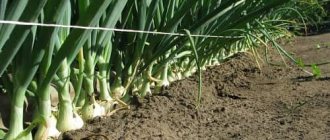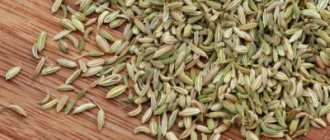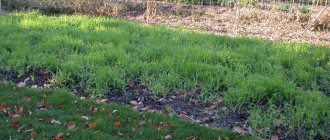Vegetable growing » Garlic
0
2248
Article rating
Kira Stoletova
Fans of vegetables grown on their own in their country garden are interested in what to plant garlic after, so as not only not to lose the harvest, but also to grow a lot of large garlic heads.
Planting garlic
What is crop rotation
According to the general rule of crop rotation, garlic crops are not grown in the same place for more than 2 years in a row. When planting vegetables in the same bed in the third and fourth years, summer residents often end up with weak, disease-damaged plants. The way out of this unfavorable situation is to change the crops grown.
Rules for changing crops
The table below shows the order of changing crops grown in the garden.
| Item no. | How to fertilize | Name of culture |
| 1 | Requires an abundance of organic elements | Pumpkin, cucumbers, cabbage, zucchini, legumes, strawberries, currants |
| 2. | Does not require large amounts of fertilizer | Garlic, tomatoes, radishes |
| 3. | Need mineral supplementation | Root vegetables - Onions, carrots, turnips, beets |
| 4. | Need to fertilize the soil with mineral compounds before planting | Potato |
Planting winter garlic
Winter varieties are recommended to be planted from October 20 to November 20. If planted later, the plant will freeze and die. In the middle zone, gardeners plant garlic at the end of September.
Before planting crops, you should not fertilize the soil with manure. Garlic grows best in fertile and neutral soils. Manure makes the soil acidic, creating a harmful excess of nitrogen. You can add peat when digging the soil on the bayonet of a shovel. You can add 20 g of superphosphate and 20 g of potash fertilizer per square meter. Before planting the plant, add 15 g of ammonium nitrate.
Winter garlic loves loose sandy loam, but does not tolerate shade and strong humidity. Groundwater can harm the plant. Therefore, it is better not to grow the crop in the lowlands.
Soaking planting material in a solution of potassium permanganate will prevent diseases. It should be pink. The teeth should be left in water for 2 hours. You can put them in a saline solution for 2-3 minutes. It has a more powerful disinfectant effect. Add 1 small spoon of salt to 2 liters of water.
What are the benefits of crop rotation?
As a general rule, agricultural plants grown in the garden are divided into groups based on the principle of the same substances they require, which serve as stimulants for growth and development. These groups of vegetable crops are fed with the same mineral compounds and fertilizers.
After suitable predecessors, the nutritional components necessary for beginners remain in the soil layer.
The root system is also important. For example, when asked what is the best time to plant garlic before winter, the answer should be: after a crop with long roots. Such plants deplete the deep layers of soil during growth, but do not touch the upper layers, which feed the short garlic roots. The long root system of crops loosens the soil, raising nutrients closer to the surface and making it permeable to air and water.
Recommendations for predecessors
Favorable predecessors of garlic are quickly ripening plants. They do not have time to take away all the useful substances and organic fertilizers applied to them. This organic matter will be used by garlic after them, especially since it is contraindicated for it in fresh form. So, for example, a pumpkin will not only leave its nutrition for it, but will also not transmit diseases, since they are different.
The best predecessors of garlic are legumes.
The bacteria contained in their roots produce nitrogen, which is an important fertilizer for garlic. The root system of legumes also loosens heavy soils, allowing the soil to be enriched with oxygen.
Berries such as currants, strawberries, strawberries can also be useful. You can be tolerant of places where medium-ripening crops grew.
Gardeners advise planting alfalfa, clover, and mustard in the garden where garlic is supposed to be planted in the fall. They will act as green manure, enrich the soil with useful microelements, and improve its structure.
Since the roots of garlic feed on substances from the surface layer, it should be planted after long-rooted plants that take components from deep layers of the earth, and in no case after root and tuber crops (potatoes, beets, onions, greens), which deplete the top layer. Moreover, they have the same diseases as garlic (fusarium, nematodes).
Herbs with a spicy smell have a depressing effect on the development of garlic and worsen its aroma.
Garlic compatibility table with specific crops
| Compatibility | Predecessors |
| The best |
|
| Possible |
|
| Not recommended |
|
After which crops should garlic be planted?
A bed in which vegetable crops grew, after which garlic can be planted before winter, is considered favorable.
Cereals
With the exception of oats and barley, all cereals are excellent precursors after which garlic can be planted. During the gardening season, the long roots of cereal crops prepare the soil for planting garlic for the winter, and the stems and foliage of plants enrich the soil with the necessary mineral components.
Vegetables
After cucumbers, white and cauliflower, zucchini and squash with eggplants, which also have a developed measles system, the garlic crop also grows and develops well, and the pests and diseases common among them are not afraid of it.
Melons and beans
Pumpkin and beans and peas are suitable as good predecessors.
Berries
Summer residents harvest excellent winter garlic crops from beds where strawberries or garden strawberries were grown before garlic planting. Some, with limited acreage, have adapted to plant it together with strawberries in the same bed.
Rules for planting and caring for plants
There are two technologies for planting garlic in open ground:
- grooved;
- nesting
Both technologies are common among gardeners and gardeners. Furrow planting can be carried out in long rows on narrow beds, no more than 0.5-0.6 m wide.
Long rows
For those gardeners who have wider beds on their plots - 0.7-0.8 m, it is advisable to use furrow sowing of garlic and plant the cloves in short rows.
On beds of irregular configuration, nest planting of garlic is used. To implement this, use a wide stick or a device in the form of a knot, which can go deep to a garlic planting depth of 5-6 cm. It should be noted that caring for such a plantation is more difficult. Weeds that appear in the middle of the bed will be difficult to remove.
The scheme for planting garlic for furrow technology is 20-30 cm between rows, 15-25 cm in rows, depending on the variety and plant growth vigor. For nest planting, plant using the square method 15×15, 20×20 or 25×25 cm.
Contrary to the opinion of many gardeners, you should not plant garlic in joint plantings as close as possible to strawberries or other crops. The optimal distance to neighboring crops and strawberries is 25 cm. This distance will prevent strawberry bushes from shading.
Soil preparation
To grow a high yield of winter garlic, you need to properly prepare the soil. After peas, you don’t need to add humus, but after other crops it’s good to add 10-12 kg of humus per 1 m2. Organic mass is evenly distributed over the area. Then mineral fertilizers containing nitrogen, phosphorus and potassium are scattered. All components are thoroughly mixed during deep digging.
Important! Fresh manure should not be applied under garlic.
Applying fresh manure before planting the cloves may cause them to burn. If the cloves survive, the plants begin to fatten in the spring. Rotted manure or fertilizing with fresh manure is acceptable for a predecessor, for example, cucumbers or zucchini.
After what crops should garlic not be planted?
Preparing the ground
There are a number of crops after which you should not plant garlic before winter.
- Onion. You cannot plant winter garlic crops after onion crops. A similar root system of onions will reduce yields when planted immediately after the harvested onion crop. In addition, these two crops are susceptible to the same diseases and have similar pests, belonging to the same group. This is also the reason why winter vegetables cannot be planted after onions.
- Tomatoes. Tomatoes grown in the garden usually strongly acidify the soil layer, which adversely affects the growth and development of the garlic crop. When harvesting tomatoes, the soil is treated by planting green manure, after which garlic seeds are planted at the next stage.
- Roots. Winter crops are not planted after vegetables such as carrots, potatoes and beets. When growing these vegetables, especially potatoes, it is necessary to add too many mineral compounds, and for garlic crops this is unnecessary. Carrots quite deplete the top cover of the soil, so the garlic vegetable with its short root system cannot be planted immediately after it.
Good and bad neighbors for garlic
It is important not only to choose suitable predecessors, but also good neighbors in the bed, next to which the spice plant will grow comfortably.
It is recommended to plant garlic next to the following plants: strawberries, beets, tomatoes, carrots, cucumbers . It has a beneficial effect on these crops, because it repels aphids , carrot flies , and mole crickets . In addition, proximity to calendula, chicory, and horseradish is beneficial .
Despite the fact that garlic is a very good and useful neighbor in the garden, not all vegetables and plants will like its company. The proximity of garlic to the following crops is undesirable: parsnips, peas, beans, lentils.
Note! If you are interested in other useful and detailed information about this spicy plant, then you can read it in the following articles: planting winter garlic in the fall , features of feeding and fertilizing , spring planting , harvest dates , as well as features and methods of storage in winter .
Maintaining crop rotation in your garden or summer cottage is not a difficult task. If you have a large plot and it is difficult to remember the location of different crops, you can take notes on paper or electronic media. Thanks to a completely justified rotation of crops, you will be able to maintain optimal soil condition and grow all the necessary vegetables, including winter garlic.
Do you plant garlic after garlic?
Vegetable growers are trying to plant the beds from the garlic crop with other vegetable crops.
If there is not enough space on the site, you can use a little trick: plant green manure at the end of summer before winter. By autumn, garlic seeds can be planted in such a cleaned bed.
Spinach or all types of salads are suitable for planting. The main condition for such plantings is a short growing season. Following the harvesting of the green crop, the soil is sown with green manure: rye or mustard will grow before the onset of cold weather, enrich the soil depleted of garlic crops with the nitrogen component and useful elements, and restore its fertility. You can plant garlic seeds again in the winter.
Advice from experienced agronomists
For planting before winter, it is recommended to choose special varieties: Gribovsky, Petrovsky, Komsomolets.
Experienced summer residents advise mulching the beds with plantings during the cold season. For this, fallen leaves, conifer needles, and peat are best suited. The thickness of the covering layer is at least 10-15 cm.
As the weather warms up, the mulch is removed. After the first shoots appear, it is recommended to fertilize the seedlings with nitrogen fertilizers. At the end of June, it is necessary to remove the formed arrows and feed the crop with ash.
Gardening Tips and Tricks
Experienced gardeners often resort to some tricks when planting garlic in the fall before winter, which allow them to get a rich and tasty harvest the following year.
These techniques can be used by both beginners and those who are planting garlic before winter for the first time. So, these tricks include:
- Determination of soil acidity using an acid meter. An acid meter is a specialized device that allows you to determine the Ph level with maximum accuracy.
- Timely preparation of the bed. It may vary from region to region, but it is best to start it in August. This is done to ensure that the loosening period lasts as long as possible: this will remove all weeds from the bed.
- The right choice of location. It is necessary to take into account not only the composition of the soil substrate, but also the geography of the site. Garlic should not be planted before winter in poorly lit lowlands where rainwater accumulates. Even if garlic can cope with a lack of light, excess water will be detrimental to it.
Care
The feeding schedule does not coincide in terms of timing, but is the same in content.
| View | Nitrogen | Phosphorus+Potassium |
| Winter | By shoots (after 7-10 days) | Initially - before planting, then twice after nitrogen fertilizing with an interval of 3-4 weeks |
| Spring | For landing | Twice with an interval of a month after germination |
Mulching crops with hay and humus - protection from premature evaporation of moisture and additional nutrition. A gardener who covers the ground with a thick layer of straw or rotted sawdust gets rid of the need for regular weeding and loosening. In other cases, these measures are mandatory because:
- weeds compete with the crop for food, moisture, light;
- soil that has become compacted after watering does not allow oxygen, which is necessary for roots and bulbs, to pass through.
Winter garlic seedlings do not need watering: melt water will satisfy the need for moisture. And the spring one begins to germinate when the soil is already dry and the sun is warm. Therefore, intensive hydration is necessary. In the future, both varieties have the same watering schedule: regular until a month remains before harvest.
The fundamental difference between summer and winter garlic is bolting. When growing, take into account that the flowering shoot of winter varieties must be broken off so that the result - the garlic head - is pleasing in size.
What to do if there are no suitable predecessors?
The lack of good predecessors is not yet a reason to abandon the idea of \u200b\u200bgrowing garlic.
Firstly, you can incorporate green manure into the soil, which will provide the crop with a sufficient amount of nutrients.
Secondly, you can try planting garlic in the fall before winter where neutral crops previously grew. Even if this does not give a positive effect, however, if you follow the rules for planting and fertilizing, it is quite possible to grow a healthy crop even after neutral predecessors.
Thirdly, the lack of good precursors can be mitigated by high-quality soil (i.e., add mineral (superphosphate and potassium sulfate) and organic (wood ash) fertilizers to the soil, and also bring the acidity of the soil to a normal level).
Groups of vegetable crops
To understand the rotation of crops in the garden, it is important to understand into which groups all plantings (vegetables and grains) are divided. They look like this:
| Group | Name |
| Tuber | Jerusalem artichoke, potatoes and sweet potatoes |
| Root vegetable | Carrots, beets, radishes and turnips, radishes, as well as parsley, celery |
| Legumes | Peas, chickpeas, lentils and beans |
| Solanaceae | Tomato, pepper, and eggplant |
| Bulbous | Garlic and onion |
| Melons | Melon, pumpkin, watermelon, squash, zucchini |
| Brassicas | All varieties of cabbage |
What can be incorporated into the soil when planting garlic before winter?
To improve fertility, green manure is added to the soil before winter.
Green manure is the general name for agricultural crops (there are about 400 of them in total), which are embedded in the soil. The result of such procedures is the enrichment of the site with nutrients (primarily nitrogen) and the reduction of weed growth.
For a crop such as garlic, the problem of fighting nematodes, or roundworms, is acute. Therefore, mustard is suitable for embedding into the ground before planting in the fall, since its root system has properties that repel nematodes. Of all the varieties of mustard, white is the best choice.
IMPORTANT! You cannot plant both garlic and green manure at the same time. At least 4-6 days must pass from the moment the last ones were added (if green manure was added at the same time as the bed was being prepared, you need to wait 2 weeks).
If green manure is not embedded in the ground, then there are two options for planting garlic in the fall before winter:
- in rows into a kind of “carpet” of enrichment plants;
- rows between planted vegetables.
What is the difference between preparing planting material?
Strengthening the resistance of garlic against pests and increasing immunity to infections will not interfere with either winter or spring varieties. The most popular for these purposes are salt and potassium permanganate. To etch the teeth with the first solution, dilute a tablespoon in a liter of water. You can prepare the seeds using the second method by obtaining a pink solution of manganese.
The differences are the time for which the teeth are soaked:
- Long-term moisture will harm winter crops and will speed up germination. 15-20 minutes for each drug is the optimal time.
- In spring, daily soaking will help them hatch faster. For 10-12 hours - salt, the rest of the time - potassium permanganate.
Summer garlic is more susceptible to insect attacks: it germinates later when pest activity increases. Therefore, it is not recommended to neglect processing. For planting spring garlic, the outermost cloves are selected - they are larger.
One of the other etching options is in the video:
In winter garlic, all the cloves of the head are used. You can propagate bolting varieties using bulbs from the air. These garlic seeds will produce single cloves in a year. Having planted them, the summer resident, after another gardening period, will harvest full-fledged large heads.
Common mistakes
Beginners in planting and caring for vegetables make a number of typical mistakes caused either by a lack of experience, knowledge, or both. Such shortcomings include:
- Watering too often. Although garlic is a moisture-loving crop, it should not be overwatered. In order for the ground to be saturated with moisture in the required volume (15-20 cm deep), you will need 3-4 buckets of water per 1 square meter. On rainy days, watering is stopped, on dry days it is resumed at intervals of every 4-5 days.
- Determination of soil acidity using “folk-visual” methods. Determining the acidity level based on what grows on the site should only be used when there is no access to specialized tools, since this method does not give accurate results.
Basic concepts and principles
Crop rotation is the alternation of crops in the garden. To get a consistently good harvest, you need to correctly draw up a crop rotation scheme! If some people think that they cannot cope with this task, then they are mistaken. To correctly draw up a scheme, it is enough to know the basic principles of crop rotation, which clearly explain which vegetables can be planted after which crops
The most important rule: It is not recommended to plant plants from the same family in the same place, but there are still exceptions. It is also not advisable to plant crops with the highest nutrient requirements ahead of those with lower nutrient requirements.
Dividing plants according to their level of nutrient needs:
- High level – potatoes, zucchini, cabbage, spinach, celery, pumpkin. A special feature of crop rotation is potatoes and cabbage - these crops can be grown in one place for several seasons in a row.
- Medium level - cucumber, melon, radish, eggplant, tomato, beets, carrots.
- Low level – bush beans, onions, radishes, lettuce.
Therefore, what to plant after beets can be calculated based on this list.











